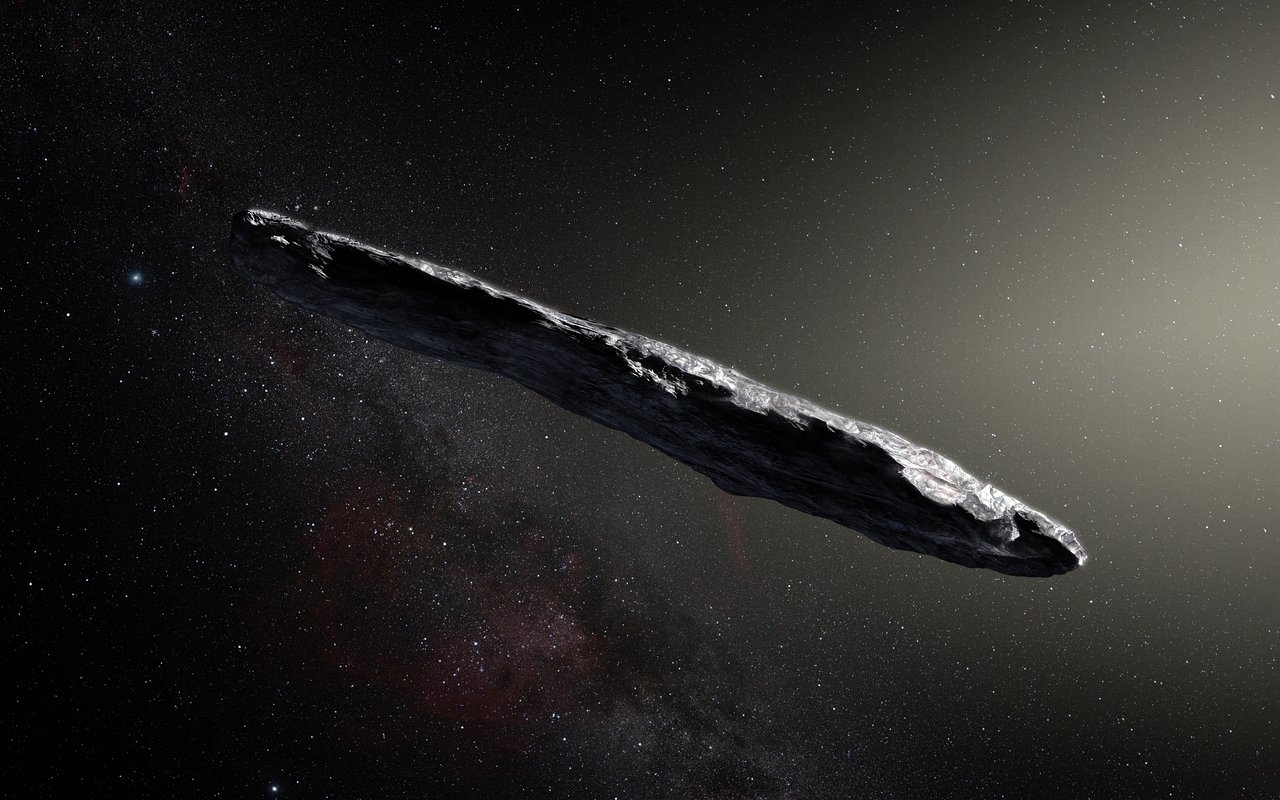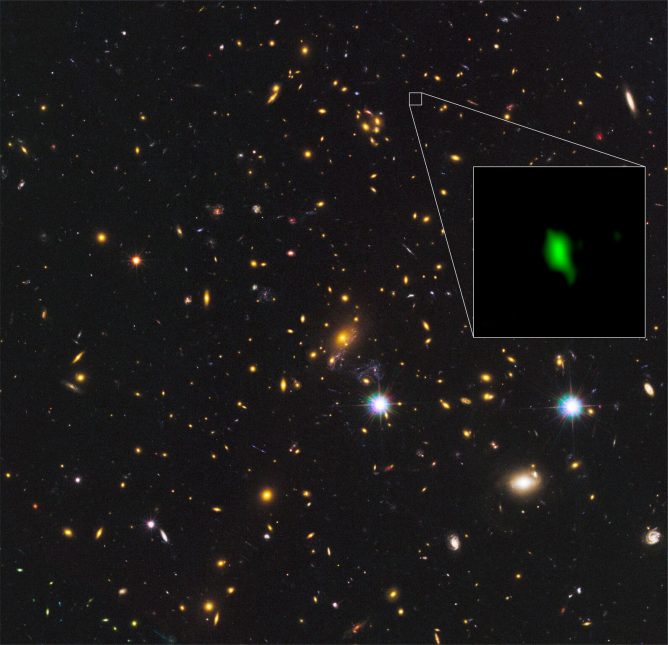2018.05.29
Universe Observed through Visual Acuity of 120,000/20 [vol.3] Observing Solar System Objects with ALMA
An Interstellar Visitor to Our Solar System?
—– Today we’d like to hear about the comet that might be possibly coming from the outside the solar system. It may not be a comet though.
A week before this interview, there was a discovery of a small body which was supposed to be the first object from the interstellar space (later named “Oumuamua”)
Watanabe: After all, no comet-like activity was found. A comet must have a thin atmosphere of gas called “coma” around it and gas emission, but the observed one has nothing like that. So, it might possibly be an object from outside the solar system.
—– Hasn’t it been confirmed yet?
Watanabe: There is a place called “Oort Cloud” where a group of icy bodies spherically surrounding the solar system, which is supposed to be a reservoir of comets. Sometimes neighboring stars are coming closer to our solar system, then the solar system is shaken by the gravity of the star. With such a shakeup, icy bodies could sometimes take an extreme orbit toward the Sun that looks like coming from outside the solar system as observed this time, instead of being pushed out of the solar system.
—– Isn’t it clear yet if the object came from the Oort Cloud or from the outside solar system?
Watanabe: There was no indication that it came from the Oort Cloud as a result of detailed calculation of its orbit. If it was a comet with gas emission, it could have been much more interesting. From its components, we could have studied the difference between a comet coming from outside the system and in the solar system.
—– Do you think any new findings would be presented by an ALMA observation of this object?
Watanabe: Hopefully such observation will actually happen. ALMA is capable of observing microwaves emitted from extremely low temperature objects. Furthermore, since the object has an apparent magnitude of 20, we will be able to calculate the size of the object and the reflectivity of its surface by combining the microwave and optical data. If the reflectivity turns out to be as high as95%, the object might be proved to be not a celestial object but a starship! (Laugh) But actually its reflectivity seems reddish and low according to the observed reflection in the optical to infrared spectrum.
How Does ALMA Observe Solar System Objects?
—– What exactly is seen in ALMA observation of solar system objects? You said earlier, “ALMA is capable of observing microwaves emitted from extremely low temperature objects”.
Watanabe: All bodies in the solar system are heated by the Sun. Some giant planets have internal heat source. Heated bodies emit specific light depending on the temperature, which is called black body radiation. Relatively high-temperature bodies emit strong infrared radiation, while distant and cold bodies emit millimeter and submillimeter waves at longer wavelengths.
—– What temperature is it when you say high or low temperature here?
Watanabe: Interstellar bodies can be cooled to a temperature close to -270 degrees Celsius, when they are blocked from sunlight. On the other hand, when heated by sunlight, interstellar bodies approximately in a distance from the Sun to Earth are heated to 0 degrees and emits strong infrared radiation. In a longer distance from the Sun, the temperature will be around -50 to -100 degrees Celsius. Objects at such temperature emit millimeter and submillimeter waves, which can be detected with ALMA.
—– The temperature at -100 degrees feels extremely cold to us.
Watanabe: It must be. But given that the temperature of the universe is -270 degrees, the temperature of -100 degrees is relatively quite warm. The point is that we can see microwave emissions from something heated. Thus asteroids, moons, and a variety of minor bodies at a greater distance than Neptune, called trans-Neptunian objects, are ALMA’s important targets.
Another target is microwave emissions from atmospheres surrounding the objects or gas ejection from the objects. It allows us to identify what materials are contained in the atmosphere or gas as well as kinematic behavior of these materials.
—– As you mentioned earlier, we could have studied more in detail if gas emission was detected in that small body which might have come from the outside solar system.
Watanabe: Right. On earth, we can measure wind direction very accurately using observing instruments at various locations. On the other hand, for distant planets where we cannot launch multiple probes at once, we have to see how the wind blows there by ground-based observations. But it was not so easy. For example, Jupiter has clouds and we can see how the wind blows by studying the shape and movement of the clouds. But, if a body is surrounded by transparent atmosphere like Mars, we cannot see anything. Then, in that case, we examine emissions from molecules contained in the atmosphere to estimate the wind direction from Doppler effect. Actually, ALMA is observing the transparent atmosphere of Pluto. The results will be very valuable data for researchers of planetary atmospheres.
In addition, when probing traces of molecules contained in the atmospheres, they can be better detected by observation as a whole from a distance. It will be more difficult to detect such a tiny amount of molecules if we send a probe to the site, because the observable volume from a probe is limited.
—– I see.
Watanabe: Detection will be easier by ALMA because it can observe as if it penetrates the whole depth of the atmosphere with small quantities of molecules accumulated. Taking advantage of such strength, ALMA is used to study the molecules in the atmosphere of Saturn’s largest moon, Titan, for example.

Figure: Acrylonitrile, an organic molecule, was detected in Saturn’s largest moon, Titan by ALMA observation. Observing organic molecules of Titan, as an astronomical object thought to be similar to early Earth, may provide a clue to the origin of life on earth. The figure shows a molecular diagram of Acrylonitrile. The image of Titan was created by combining an optical image of the atmosphere and an infrared image of its surface captured by Cassini spacecraft.
Credit: B. Saxton (NRAO/AUI/NSF); NASA
Rotation of Asteroid Juno Unveiled !
—– Among the solar system objects observed by ALMA, what surprised you the most?
Watanabe: I was really surprised to see the high-resolution image of the asteroid Juno 300 million kilometers away from Earth. We could even see its rotating movement.
—– It looks like an image captured at a close range by a spacecraft.
Watanabe: Actually, the optical Hooker Telescope has discovered a crater on Juno, which was captured more clearly than ALMA. But it took long to obtain an image and required a lot of image processing afterward. Considering this, it is very difficult to take an image of the rotation of the asteroid. Compared to that taken by the Hooker Telescope, the image taken by ALMA appears a little blurry but very impressive for its high time-resolution that enables to catch up with the movement of the object instantly.
—– You mean, it is necessary to capture the image with no delay if we want to see an object that changes every second.
Watanabe: Also, ALMA observation allows to study different thermal inertia of target objects to see whether the surface of the object tends to be easily heated or not.
—– Then, you will study thermal conductivity to identify the ingredients of the solid object.
Watanabe: It’s one of the ways to do it. If it’s an asteroid in a distance of 2 to 3 au from the Sun like Juno (twice or three times farther than the earth), observations at infrared wavelengths might also be possible because its temperature is high enough to emit infrared rays. But ALMA surely can produce good quality of data with its high sensitivity, and high temporal and spatial resolution.
I hope in the future ALMA will make observations of various asteroids and create a catalogue of asteroids that are classified according to different types of thermal inertia. It will help understand deeply the characteristics of a various types of asteroids.
Great Comet will Bring Discovery of Amino Acids?
—– It turned out that the small body that was thought to have come from outside the solar system was not a comet. Does ALMA observe comets too?
Watanabe: Yes. The comets being observed with ALMA includes Comet Lemmon that was brightening up in the early 2013, and Comet ISON that was expected to be a great comet but fell apart after making its closest approach to the Sun at the end of 2013.
—– What was found by the observations of these comets?
Watanabe: We already knew that comets contain various organic molecules. What we didn’t know was where these organic molecules have formed. For further research, we want to see how organic molecules are distributed around a comet.
The results of ALMA observation of Comet Lemmon and Comet ISON shows that organic molecules of HCN (hydrogen cyanide) are evenly distributed in the comet’s coma. On the other hand, organic molecules of HNC are not evenly distributed but they are moving in clusters inside the coma. It was not clearly captured by existing telescopes, but high resolution of ALMA enabled to unveil detailed spatial distribution.

The emission from HCN molecules in the atmosphere of comet Lemmon (left) and comet ISON (right) as observed with ALMA.
Credit: B. Saxton (NRAO/AUI/NSF); M. Cordiner, NASA, et al.
—– What is indicated by such difference of spatial distribution?
Watanabe: It is thought that, in HCN, molecules (that might be HCN itself) contained in the form of ice melts and spreads evenly across the entire coma. On the other hand, HNC is thought to be formed by degradation of organic molecules that make up dust in a comet. That is the reason why HNC is not evenly distributed. This is significant progress for researchers of comets as they can find what materials are originally contained in the comet and what materials are formed afterwards by these observations.
—– What kind of new insights can be provided by these findings?
Watanabe: I am seeing comets as primeval objects in the solar system like fossils in which information of various regions of the solar system has been preserved. So, it is important to know what materials are originally contained in the comets in understanding how the solar system was formed.
Furthermore, Comet Lemmon and Comet ISON are relatively dark mid-sized comets. It was a good surprise to us researchers that so many findings have been provided by ALMA observations of mid-sized comets, because we are now able to see what we could only see in large-scale comets that come to Earth once every 10 to 20 years. Now, as mid-sized comets like these have been found almost every year, it allows us to conduct statistical study. Given this, ALMA is a quite revolutionary telescope.
—– If a great comet comes, what can be seen with ALMA?
Watanabe: Amino acids, certainly. We didn’t have any great comet yet since ALMA started its operations. So, when it comes, I expect ALMA will find amino acids directly related to life and highly complex organic molecules in the comet.
Accurately Estimating the Size of Trans-Neptunian Objects
—– What solar system objects do you want to see with ALMA other than those mentioned in this interview such as atmospheres of planets and moons, asteroids, and comets?
Watanabe: As touched upon at the beginning, ALMA can see “trans-Neptunian Objects” that include several tens of thousands of small icy objects that orbit the Sun at a greater average distance than Neptune.
—– Is Pluto one of trans-Neptunian objects?
Watanabe: Right. ALMA observed a trans-Neptunian object farther than 3 times the distance from the Sun to Pluto. The estimated size of the object is approximately 635 km.

ALMA image of the planetary body 2014 UZ224, more informally known as DeeDee. At three times the distance of Pluto from the Sun, DeeDee is the second most distant confirmed TNO with a confirmed orbit in our solar system.
Credit: NRAO/AUI/NSF
Credit: NRAO/AUI/NSF
Actually, we used to estimate the size of trans-Neptunian objects by luminosity observed with optical telescopes. In this method, the estimated size could largely change depending on the reflectivity of the body surface. However, by adding ALMA data observed at millimeter and submillimeter wavelengths, we can derive both the size of the object and reflectivity accurately.
—– Could you explain the mechanism in more detail?
Watanabe: Imagine a shiny polished ball and a ball of mud. When we see them at close range, a ball of mud looks darker. But, when we see them in a distance, we cannot see the size or texture whether it is polished or muddy, which is reflectivity. So, we could do nothing but estimate the size of an object based on an assumed reflectivity that was measured with an asteroid.
—– So, you were estimating the size of an object from its luminosity based on an assumed reflectivity.
Watanabe: Correct. Do you remember the talk about black body radiation from solar system objects observed with ALMA?
—– You explained that celestial bodies are heated by sunlight and emit microwaves at specific wavelengths.
Watanabe: Right. If you have a big pot simmering at 100C and a small test tube with water boiling at 100C in it, you must feel hotter with a big pot when you get closer to it. Even if two bodies are in the same temperature, larger objects have stronger emissions. It means we can estimate the size of objects by the strength of microwaves. Then, we can derive the reflectivity of the surface of the object by comparing the optical luminosity and the size of the object.
—– With the optical luminosity and microwave strength, we can accurately estimate both the size and reflectivity of the object.
Watanabe: Right. The achievement of ALMA, nonetheless, is still very impressive because it successfully observed black body radiation of an object of just 600 km in diameter as far as 3 times the distance from the Sun to Pluto.
—– Now it became possible to measure the size of trans-Neptunian objects accurately. Then, is there anything we can understand further?
Watanabe: If the object size distribution becomes clear, we will be able to understand more in detail whether small trans-Neptunian objects are debris of “would-be planets” that somehow fell apart and spread into space or whether they remain small because they stopped growing as lumps of ice in the middle of the process of clustering and merging. We assume that they probably didn’t have enough time to grow into planets, but it is also possible that grown planets might have been broken and scattered around the space.
Spacecraft vs. ALMA. Which is More Suitable for Observing the Solar System?
—– Spacecraft may be more familiar to most people as a means of exploring the solar system objects. What advantage and disadvantage are there in using a spacecraft and in observing with ground-based telescopes like ALMA respectively?
Watanabe: Spacecrafts are good at probing something specific in detail at the place of destination. So, if you have something specific to survey, spacecrafts have more advantages. However, it’s not easy to send a spacecraft because it costs time and money for development and launch. And even if it has been launched, the period of observation is limited to 5 to 10 years. On the other hand, the ground-based observation has the advantage of being able to monitor changes of an object over 100 years.
—– That is a kind of advantage you can recognize only after continued long-term ground-based observations.
Watanabe: True. Furthermore, ALMA allows us to look into an object closely part by part. The changes in the atmosphere and climate of Mars can be mapped by seeing a certain kind of molecule in the atmosphere of Mars. It wasn’t possible from the Earth before ALMA. Since many space probes have been sent to Mars, we can see detailed topographical structures of Mars but we cannot see global atmospheric circulation or meteorological conditions. From this point of view, I think spacecrafts and ALMA can work very well in a complementary way.
—– Combining the strengths of different systems, we can have a deeper understanding.
Watanabe: However, with regard to the cost, we used to say ground-based observations could be cheaper but ALMA is quite expensive (laugh). Nevertheless, considering its long-term operation, ground-based observations will be absolutely cheaper than spacecrafts.
—– I heard there have been only a small number of observations of solar system objects made with ALMA. What is the perspective for the future?
Watanabe: It was not easy to have an observing proposal accepted through intense competition of proposals. But it is expected that there will be more observing proposals targeting solar system objects to be approved as the competition is getting less fierce. Then, I think remarkable results will be produced soon.
—– What would you like to see if you were allowed to use ALMA freely?
Watanabe: I’d like to see all comets thoroughly. Ingredients of comets are thought to have differences depending on their forming regions, but the past observations results didn’t show such large differences. Optical telescopes have limited capabilities in examining the difference of ingredients. So, we are looking forward to seeing it with ALMA.




![Universe Observed through Visual Acuity of 120,000/20 [vol.1] Astronomers Stunned by HL Tauri](https://alma-telescope.jp/assets/uploads/2017/03/naoj_alma_hltau_141106_01-1-668x668.jpg)
![Universe Observed through Visual Acuity of 120,000/20 [vol.2] Searching First Galaxy in the Universe](https://alma-telescope.jp/assets/uploads/sites/alma.mtk.nao.ac.jp/j/news/files/editor/131118_himiko_ai_sm_1-668x668.jpg)





